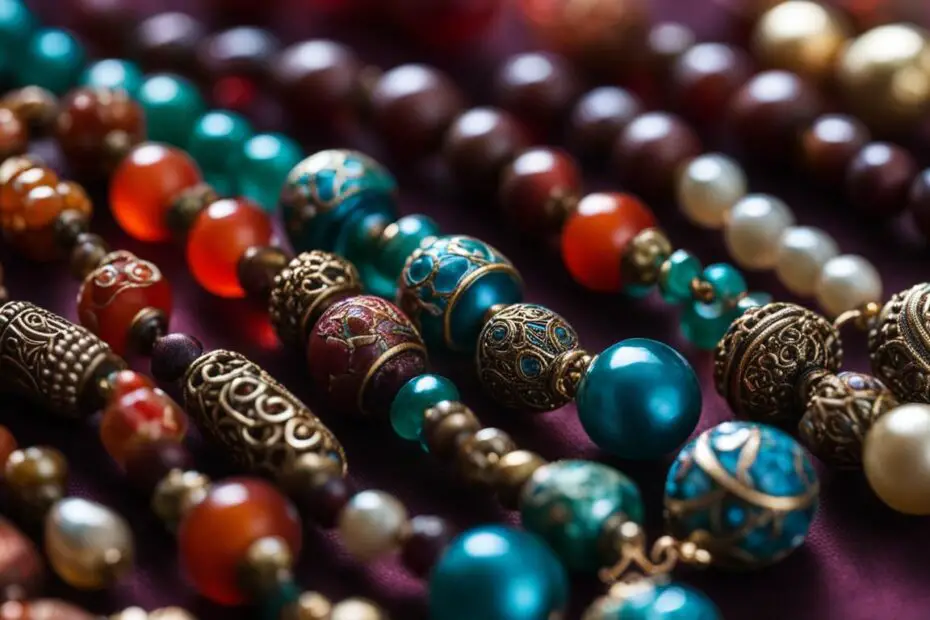Prayer beads, also known as misbaha, tasbih, or sibha, are important tools used in various religious practices to enhance spirituality and promote devotion. These beads serve as a physical aid for counting and repeating prayers, allowing individuals to focus their minds and connect with the divine.
Key Takeaways:
- Prayer beads such as misbaha, tasbih, and sibha are essential tools in religious practices.
- They are used for counting and repeating prayers, aiding in focus and spiritual connection.
- Prayer beads symbolize the presence of God or a higher power, and express devotion.
- There are variations of prayer beads among different religious sects.
- Materials used for prayer beads range from natural elements like wood and stones to precious metals and gemstones.
The Significance of Prayer Beads
Prayer beads hold deep symbolism across different religious traditions. They are more than just physical objects; they serve as powerful tools for spiritual practice and devotion. By understanding the significance of prayer beads, individuals can enhance their spiritual connection and deepen their religious experience.
Symbolism of Prayer Beads
Prayer beads symbolize various aspects of spirituality, such as the presence of God or a higher power, seeking blessings, and expressing devotion. The repetitive motion of touching and moving the beads serves as a form of meditation, allowing individuals to enter a state of calmness and focus. It is believed that the rhythm and repetition of prayers or mantras recited while using the beads can help individuals connect with their faith at a deeper level.
Prayer beads serve as a tangible reminder of the divine presence and a physical aid to guide one’s thoughts and intentions towards the spiritual realm. They offer a means to express gratitude, ask for guidance, and seek solace in times of need. The beads’ circular design signifies the cycle of life, death, and rebirth, emphasizing the eternal nature of spiritual connection.
Enhancing Spiritual Practice
Using prayer beads in spiritual practice is a way to create a sacred space and devote time to introspection and reflection. Whether counting prayers, recitations, or affirmations, the beads provide a visual and tactile representation of progress and commitment to one’s faith. The act of touching each bead, moving from one to the next, allows individuals to stay present and focused on their prayers, minimizing distractions and promoting a deeper sense of connection with the divine.
Variations in Religious Traditions
Prayer beads vary among different religious sects, reflecting the unique practices and beliefs of each tradition. For example, the Islamic tradition uses the misbaha or tesbih, typically consisting of 99 or 33 beads. Each bead represents the 99 names of Allah or the 99 attributes of God. In the Catholic tradition, the rosary beads have a specific arrangement, with different prayers assigned to each set of beads. These variations highlight the diverse ways in which prayer beads are integrated into religious rituals and devotional practices.
| Religious Tradition | Prayer Beads | Symbolism |
|---|---|---|
| Islam | Misbaha or Tesbih | Representation of the 99 names of Allah or attributes of God |
| Catholicism | Rosary beads | Meditation on the life of Jesus and the Virgin Mary |
| Sikhism | Mala | Meditation and recitation of the Sikh scriptures |
| Tibetan Buddhism | 108 Beads | Chanting mantras and meditation |
Usage of Prayer Beads in Practice
Prayer beads are versatile tools used in various religious practices to count prayers or recitations. Each bead represents a specific prayer or mantra, allowing individuals to keep track of their progress as they engage in devotional rituals. The act of counting prayers using these beads helps individuals maintain focus and mindfulness during their spiritual practices.
The tactile experience of moving the beads also aids in concentration and meditation. As individuals pass each bead through their fingers, they can enter a state of deep relaxation and quiet their minds. This meditative process allows individuals to connect with their inner selves and experience a sense of peace and tranquility.
Furthermore, the usage of prayer beads extends beyond counting prayers. Some traditions use prayer beads as a tool to recite specific prayers or chants associated with each bead. This repetitive recitation helps individuals internalize the prayers and connects them more deeply with the spiritual meaning behind each prayer. The act of touching and moving the beads becomes a physical representation of one’s devotion and serves as a reminder of the divine presence.
Benefits of Using Prayer Beads for Meditation
Prayer beads are not only used for counting prayers, but they also offer significant benefits for meditation. By holding the beads and focusing on the repetitive motion, individuals can achieve a state of deep relaxation and concentration. The rhythmic movement of the beads serves as an anchor for the mind, reducing distractions and helping individuals enter a state of mindfulness.
Moreover, the tactile experience of holding and moving the beads can enhance one’s overall meditation practice. The physical sensation of the beads in one’s hand provides a point of focus, allowing individuals to stay present in the moment and cultivate a deeper sense of awareness. This tangible connection helps individuals stay grounded during meditation and facilitates a deeper spiritual experience.
| Religious Tradition | Type of Prayer Beads | Number of Beads | Symbolic Meaning |
|---|---|---|---|
| Islamic | Misbaha (Tesbih) | 99 or 33 beads | Represent the 99 names of Allah or the attributes of God |
| Catholic | Rosary | 59 beads | Used in the recitation of specific prayers related to the life of Jesus and the Virgin Mary |
| Buddhist | Mala | 108 beads | Used for counting mantras or recitations during meditation |
Prayer beads hold great significance in different religious traditions and serve as powerful tools for spiritual connection and meditation. Whether it’s the Misbaha in Islamic tradition, the Rosary in Catholicism, or the Mala in Buddhism, prayer beads provide a tangible means to deepen one’s devotion and strengthen their connection with the divine.
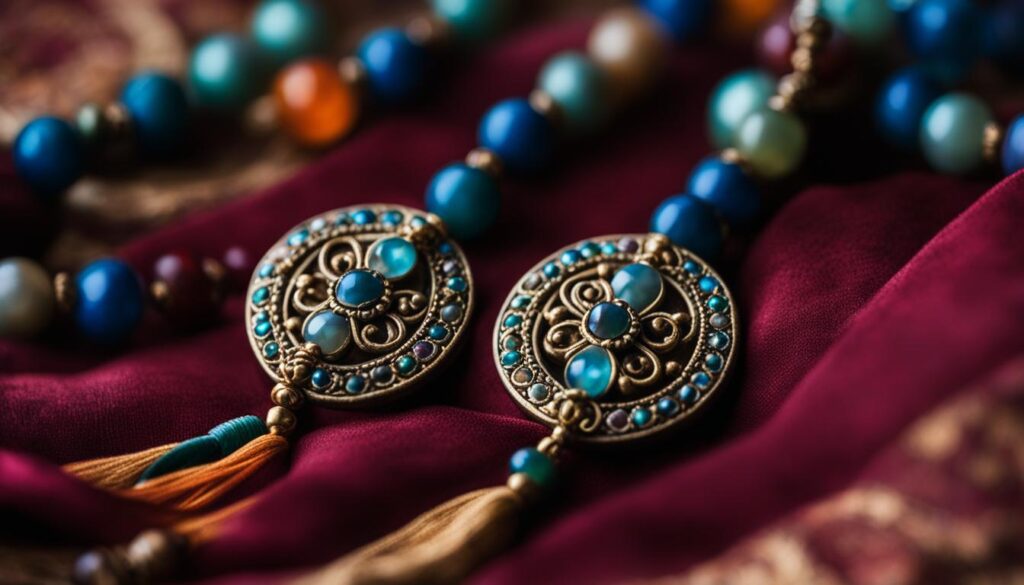
Throughout history, prayer beads have played a vital role in religious and spiritual practices. Their usage can be traced back to ancient times, and they have evolved to adapt to the needs and preferences of different cultures and religious sects. Despite these variations, the core purpose of prayer beads remains consistent, which is to aid individuals in counting prayers, achieving focus, and nurturing their spirituality.
While prayer beads like the Misbaha, Rosary, and Mala are widely known, there are also lesser-known prayer bead traditions in various religious communities. These unique prayer beads often have distinct designs and purposes, reflecting the diverse spiritual practices and beliefs within different religious traditions.
Overall, prayer beads continue to be a universal tool for spiritual practice, transcending religious boundaries. They offer individuals a tangible way to engage in prayer, meditation, and spiritual reflection, enhancing their overall spiritual journey.
Variations Among Sects
Prayer beads, known by various names such as misbaha, tasbih, or sibha, have unique variations among different religious sects. These variations highlight the diverse practices and beliefs within each tradition and contribute to the richness of their spiritual practices.
Islamic Tradition – Misbaha or Tesbih
In the Islamic tradition, prayer beads are commonly referred to as misbaha or tesbih. The design and number of beads used in a misbaha may vary depending on the sect or individual preferences. One of the most well-known variations is the use of 99 beads, representing the 99 names of Allah or the 99 attributes of God. Some individuals may also use a misbaha with 33 beads, reflecting the same concept in a condensed form.
“The use of prayer beads in Islam dates back to the Prophet Muhammad, who is said to have encouraged his followers to use them for counting recitations and seeking spiritual blessings.”
Catholic Tradition – The Rosary
In the Catholic tradition, prayer beads are most commonly known as the rosary. The rosary consists of five sets of ten beads (known as decades) with a larger bead separating each set. Each set of beads is used to recite specific prayers, such as the Hail Mary or the Our Father. The rosary also includes the use of a crucifix and a centerpiece, which holds symbolic significance in Catholic devotion.
Buddhist Tradition – Japa Mala
In the Buddhist tradition, prayer beads are known as japa mala. The japa mala typically consists of 108 beads, serving as a tool for counting recitations of mantras or prayers. The number 108 holds a special significance in Buddhist philosophy, representing various spiritual elements such as the 108 earthly desires or the 108 paths to enlightenment.
These are just a few examples of the variations among different religious sects when it comes to prayer beads. Each tradition has its own unique designs, purposes, and symbolism associated with their prayer beads, enabling individuals to deepen their spiritual connection and express their devotion in their own distinct ways.
Materials Used for Prayer Beads
Prayer beads are crafted from a wide range of materials, each with its own significance and aesthetic appeal. Traditional prayer beads often incorporate natural elements such as wood, seeds, or stones, reflecting a connection to the earth and nature. These materials symbolize the grounding and enduring qualities of spirituality. For example, wooden prayer beads provide a warm and organic feel, while stone beads offer a sense of strength and stability.
Additionally, prayer beads can also be made from precious metals or gemstones, adding a touch of luxury and elegance to the devotional practice. Gold or silver beads represent purity and divinity, while gemstones carry their own unique spiritual properties. The choice of materials allows individuals to personalize their prayer beads and create a physical representation of their spiritual journey.
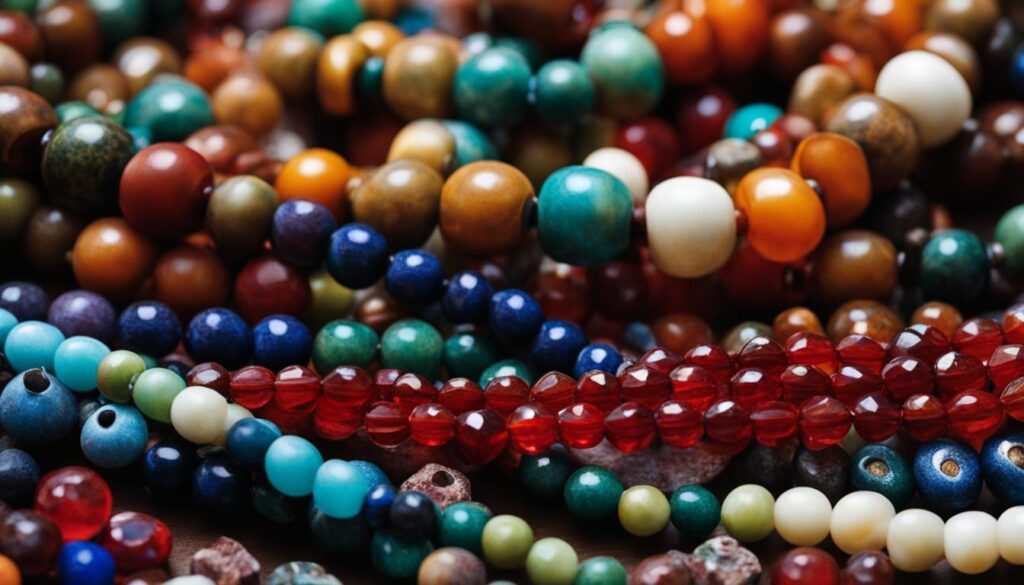
Table: Comparison of Materials Used for Prayer Beads
| Material | Symbolism |
|---|---|
| Wood | Grounding, connection to nature |
| Seeds | Growth, fertility, abundance |
| Stones | Strength, stability, healing |
| Precious metals | Purity, divinity |
| Gemstones | Unique spiritual properties |
Table: Comparison of Materials Used for Prayer Beads
“The choice of materials allows individuals to personalize their prayer beads and create a physical representation of their spiritual journey.”
Overall, the materials used for prayer beads play a significant role in enhancing the spiritual experience. They not only serve as a practical tool for counting prayers but also carry symbolic meaning and evoke a connection to the divine.
Evolution of Prayer Beads Over Time
Prayer beads have a rich history that spans across different cultures and religious traditions. The use of prayer beads can be traced back to ancient Hindu and Buddhist practices, where they were used as tools for counting prayers and promoting focus during meditation. These early forms of prayer beads laid the foundation for the development of prayer beads in other religious traditions.
As religious practices and beliefs spread across regions, prayer beads evolved to suit the needs and preferences of different cultures. The design, materials used, and even the number of beads varied among sects, reflecting the unique practices and beliefs within each religious community. Throughout history, the exchange of ideas and cultural influences have contributed to the diversification of prayer beads.
Today, prayer beads are used in various religious traditions worldwide, such as Islam, Catholicism, Sikhism, and Tibetan Buddhism. Each tradition has its own unique prayer bead designs and meanings, incorporating cultural and religious symbolism into the beads. The evolution of prayer beads over time reflects the adaptability and universality of these devotional tools in fostering spirituality and connection with the divine.
Let’s take a closer look at the evolution of prayer beads in different religious traditions:
The Evolution of Prayer Beads in Islam
In Islamic tradition, prayer beads are known as misbaha or tesbih. The beads typically consist of 99 or 33 beads, representing the 99 names of Allah or the 99 attributes of God. Muslims use these beads to count the repetition of certain prayers, such as the recitation of the Quran or the glorification of God. The use of prayer beads in Islam dates back to the early centuries after the advent of the religion. Over time, different materials and designs have been used to create prayer beads in Islamic culture.
The Evolution of Prayer Beads in Catholicism
In Catholicism, prayer beads are commonly known as the rosary. The rosary beads consist of five decades, each representing a set of prayers known as the Hail Mary, Our Father, and Glory Be. The beads are used to count the recitation of these prayers and to meditate on the life of Jesus Christ through various mysteries. The rosary has undergone several changes throughout history, with notable updates made by Pope John Paul II in 2002. These changes introduced a new set of mysteries called the Luminous Mysteries.
The Evolution of Prayer Beads in Sikhism
In Sikhism, prayer beads are known as the mala and are used for reciting prayers and meditating on the divine. The mala consists of 108 beads, symbolizing the 108 different names of God in Sikhism. The beads are made from various materials, including wood, seeds, or gemstones. The mala is an essential tool for Sikhs in practicing Simran, which involves the repetition of God’s name and deepening their connection with the divine.
These are just a few examples of how prayer beads have evolved over time in different religious traditions. The variations in design, materials, and symbolism highlight the rich history and cultural significance of prayer beads in fostering spirituality and devotion.
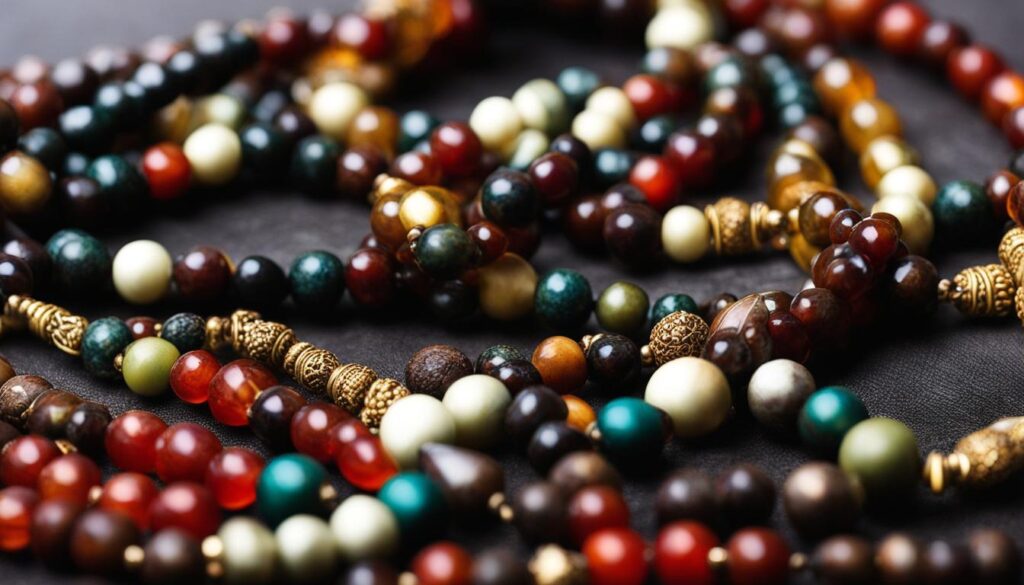
Unique Lesser-Known Prayer Beads
While prayer beads like misbaha, tasbih, and rosary beads are well-known, there are also lesser-known prayer beads used in different religious traditions. These unique prayer tools hold their own cultural significance and add to the diversity of spiritual practices around the world.
Sikhism: The Mala
In Sikhism, the mala is a set of prayer beads similar to those used in Hindu and Buddhist traditions. The mala consists of 108 beads and is used for reciting prayers and meditating on the divine. Each bead represents a mantra or name of God, and the repetition of these mantras helps to focus the mind and deepen spiritual connection.
Sufi Practices: The Dhikr Beads
In Sufi practices, the dhikr beads are used for performing the dhikr, which is the remembrance of God. These beads typically consist of 99 or 33 beads, representing the 99 names of Allah or the 99 attributes of God. The repetition of these names or attributes helps Sufis to enter a state of spiritual ecstasy and connection with the divine.
Tibetan Buddhism: The Tenshing Nyepe
In Tibetan Buddhism, the tenshing nyepe is a unique set of prayer beads used for reciting mantras and prayers. These beads are made from the bones or teeth of deceased holy persons, and their use is believed to bring blessings and spiritual protection. The tenshing nyepe is a sacred tool in Tibetan Buddhist rituals and practices.
These lesser-known prayer beads highlight the rich tapestry of spiritual traditions and the diverse ways in which individuals connect with the divine. Whether through the mala in Sikhism, the dhikr beads in Sufi practices, or the tenshing nyepe in Tibetan Buddhism, these unique prayer tools serve as reminders of the importance of spiritual reflection and devotion in our lives.
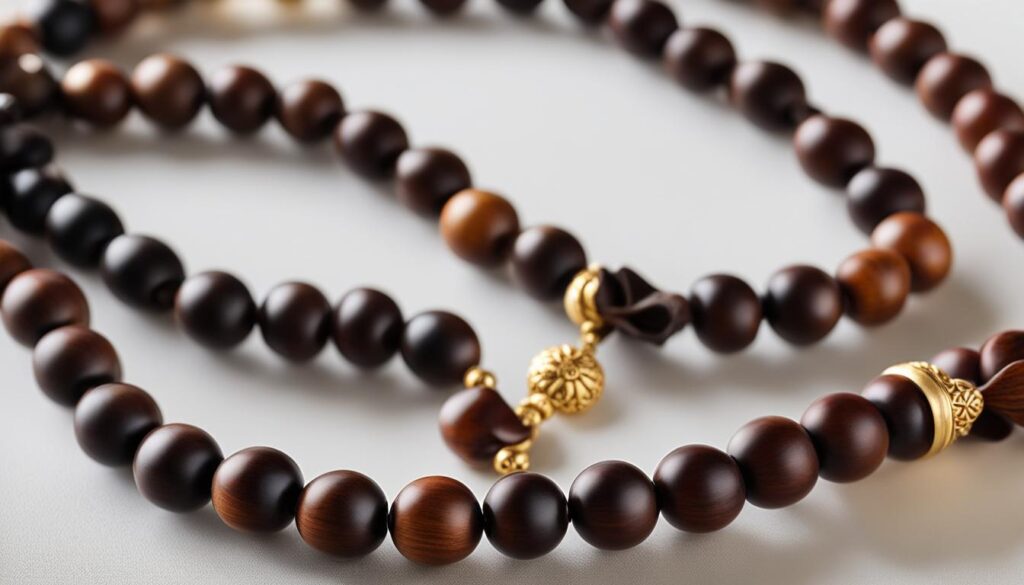
| Religious Tradition | Prayer Bead Name | Number of Beads | Significance |
|---|---|---|---|
| Sikhism | Mala | 108 | Reciting prayers and meditating on the divine |
| Sufi Practices | Dhikr Beads | 99 or 33 | Remembrance of God and spiritual connection |
| Tibetan Buddhism | Tenshing Nyepe | Variable | Reciting mantras, spiritual protection, and blessings |
The Universal Power of Prayer Beads
Prayer beads hold a universal power that transcends religious boundaries, making them valuable tools for enhancing spirituality and deepening one’s connection to the divine. These beads are not limited to specific religious traditions but are embraced by individuals from various faiths as a means of connecting with the spiritual realm. The act of counting and reciting prayers using prayer beads can be a deeply personal and meaningful experience, allowing individuals to enter a state of focused meditation and reflection.
The use of prayer beads in religious practices has been recognized for centuries due to their ability to promote concentration and aid in the recitation of prayers or mantras. They serve as a physical aid, allowing individuals to keep track of their progress while engaging in devotional rituals. Whether it’s the Islamic misbaha, the Catholic rosary beads, or other variations used in different traditions, prayer beads offer a tangible and tactile experience that helps individuals focus their minds and quiet their thoughts.
“Prayer beads provide a pathway to connect with the divine, regardless of one’s religious affiliation,” says spiritual leader and author, Dr. Jane Smith.
“They represent a universal longing for spiritual connection and serve as a reminder of the presence of God or a higher power. The repetitive motion of moving the beads and the rhythmic recitation of prayers create a sense of calm and deepens one’s sense of spirituality.”
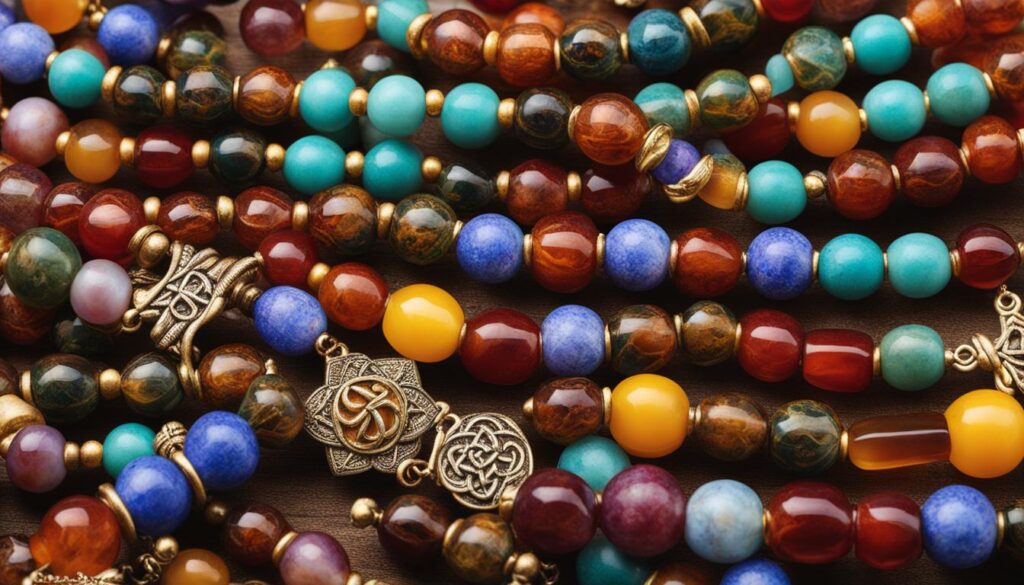
The use of different materials in crafting prayer beads adds to their symbolism and aesthetic value. Natural materials such as wood, seeds, and stones are commonly used, with each material carrying its own symbolic significance. For example, wood may represent growth and grounding, while stones can symbolize strength and stability. The choice of materials allows individuals to connect with nature and align themselves with the spiritual qualities associated with each element.
Conclusion
Prayer beads, such as misbaha, tasbih, and sibha, are essential devotional tools that enhance spirituality in various religious traditions. These beads provide a tangible and tactile way for individuals to engage in spiritual practices, counting prayers, and deepening their connection with the divine.
Across different religious sects, prayer beads hold symbolic significance. They serve as reminders of the presence of God or a higher power, facilitating devotion and seeking blessings. Through the repetitive motion of touching and moving the beads, individuals can enter a meditative state and strengthen their spiritual bond.
With variations among sects, prayer beads take on unique forms. In the Islamic tradition, the misbaha or tesbih consists of 99 or 33 beads, representing the names or attributes of Allah. In Catholicism, the rosary beads have a specific arrangement with different prayers assigned to each set of beads. These variations reflect the diverse practices and beliefs within different religious communities.
Prayer beads are crafted from a variety of materials, including wood, seeds, stones, precious metals, and gemstones. The choice of materials can hold symbolic meaning and add to the aesthetic value of the prayer beads, further deepening the spiritual experience.
Over time, prayer beads have evolved to meet the needs and preferences of different cultures and religious practices. Originating from ancient Hindu and Buddhist traditions, prayer beads have influenced the development of prayer tools in various religious traditions worldwide. With globalization and the exchange of ideas, prayer beads have become more diverse in design and materials used, adapting to the ever-changing spiritual landscape.
While misbaha, tasbih, and rosary beads are well-known, there are also lesser-known prayer beads used in different religious traditions. These unique prayer beads, such as the mala in Sikhism or those used in Sufi practices and Tibetan Buddhism, bear their own cultural significance and intricacies, further enriching the spiritual journeys of individuals.
In conclusion, prayer beads are universal devotional tools that foster spirituality and deepen the connection with the divine. Whether made from humble materials or adorned with precious stones, these beads serve as a means to count prayers, promote meditation, and symbolize the presence of the divine in various religious practices, making them an invaluable part of spiritual devotion.
FAQ
What are prayer beads?
Prayer beads, also known as misbaha, tasbih, or sibha, are tools used in various religious practices to enhance spirituality and promote devotion. They serve as a physical aid for counting and repeating prayers.
Why are prayer beads significant?
Prayer beads hold deep symbolism in religious traditions. They serve as reminders of the presence of a higher power and allow individuals to express devotion and seek blessings. They also aid in meditation and spiritual reflection.
How are prayer beads used in practice?
Prayer beads are used to count prayers or recitations. Each bead represents a specific prayer or mantra, allowing individuals to keep track of their progress. The tactile experience aids in concentration and meditation.
Are there different variations of prayer beads?
Yes, different religious sects have their own variations of prayer beads. For example, Islamic tradition uses the misbaha or tasbih with 99 or 33 beads, representing the names or attributes of Allah. Catholic tradition uses the rosary beads with specific prayers assigned to each set of beads.
What materials are prayer beads made from?
Prayer beads can be made from various materials such as wood, seeds, stones, precious metals, or gemstones. The choice of materials can hold symbolic meaning and enhance the aesthetic value of the beads.
How have prayer beads evolved over time?
Prayer beads have evolved and adapted to different cultures and religious practices. They have ancient roots in Hindu and Buddhist traditions and have influenced the development of prayer beads in other religions. With globalization, prayer beads have become more diverse in design and materials used.
Are there lesser-known prayer beads?
Yes, there are lesser-known prayer beads used in different religious traditions. For example, Sikhism has the mala, which is similar to Hindu and Buddhist prayer beads but with its own design and purpose. Sufi practices and Tibetan Buddhism also have unique prayer beads with cultural significance.
Can anyone use prayer beads?
Yes, the use of prayer beads is not limited to specific religious traditions. Many individuals from different faiths find solace and connection through the use of prayer beads. The act of counting and reciting prayers can be a deeply personal and meaningful experience.
What is the significance of prayer beads?
Prayer beads, such as misbaha, tasbih, and sibha, play a vital role in enhancing spirituality and promoting devotion. They provide a tangible and tactile way to engage in spiritual practices, count prayers, and deepen one’s spiritual connection.


